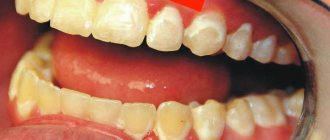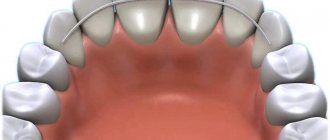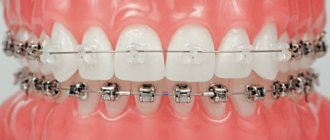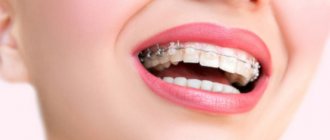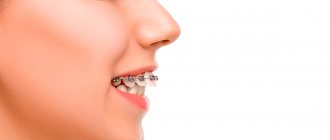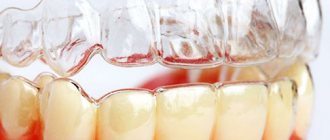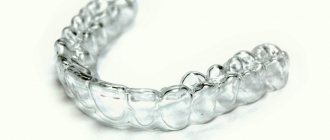What are dental guards?
Orthodontic aligners differ in functionality.
So the purpose of using products that are worn after braces is to maintain the achieved result. In addition to mouthguards, metal splints called “retainers” can also be used. Mouthguards are made of plastic material and are a product that is fixed in the oral cavity on the teeth or on the inside of the dentition. Unlike the rigid design of braces, they are comfortable to use. However, their action can be aimed at eliminating only a slight defect in tooth growth, or at preventing the teeth from returning to their previous incorrect position.
The duration of wearing retention aligners after braces can range from 6–10 months to several years. The model and material are selected individually. The mouthguard itself can be made from a cast or have a classic shape.
Types of mouthguards and use of a retainer
There are many different types of mouth guards. The devices differ in manufacturing technology, material, and wearing time. Most often, structures are made from silicone or bioplastic. The materials are not much different: they are both transparent, hypoallergenic and barely noticeable in the mouth. Based on manufacturing technology, the following types of mouth guards are distinguished:
- Standard. They are made according to a single pattern. Such devices do not take into account the individual characteristics of the bite. Therefore, some inconvenience may occur during use.
- Thermoplastic. They are made from a material that becomes soft and elastic when heated. The structure is placed in hot water and then applied to the teeth until it cools completely. Subsequently, it can be adjusted further.
- Individual. They are used after removing braces . To give them the correct shape, production is carried out on the basis of a cast of the jaw.
As for the wearing time, they are worn at night. You can wear it during the day, taking it off only when eating or brushing your teeth. They are used to consolidate the results obtained.
There are also non-removable structures - retainers. Essentially, it is a thick wire that is fixed on the inside of the teeth using a special material that does not harm the enamel. It not only fixes the teeth in the correct position, but also provides additional protection for the enamel from external influences.
The retainer is invisible to others and does not interfere with its owner in any way
The retainer is worn for 3 to 5 years, but most patients wear it for life. This is explained by the fact that with age, teeth begin to shift towards the smile zone, which leads to their displacement. An installed retainer keeps the teeth secured in their original position.
Why wear mouth guards after braces?
Malocclusion, which is a consequence of a defect in the arrangement of teeth in the jaws.
Correcting such an anomaly is difficult and treatment is not limited to wearing braces. During the entire time the structure is installed, the teeth take the correct position under mechanical pressure on them. Previously, dentists believed that such therapy was enough - after all, the dentition had become straight. However, observations of patients have confirmed that without external influence, the teeth gradually begin to return to their previous location.
Using a dental guard after braces helps hold the teeth in place until they are completely fixed in their new position. The duration of the retention stage, as a rule, exceeds the period of wearing braces twice.
Nuances when wearing mouth guards
There are some inconveniences to wearing mouth guards that patients need to be aware of. Here are the main ones:
- At first, the mouthguards may cause slight discomfort. However, after some time, most patients get used to these devices. Wearing soft aligners does not cause pain (unlike wearing braces).
The only reason for pain during treatment with mouth guards is if the patient has not worn them for some time.
This signals that the teeth are trying to take their original incorrect position.
- At first, wearing mouthguards often causes patients to have defects in the pronunciation of various sounds (usually hissing and whistling).
- Most aligners are made from clear polymers. Wearing them usually remains unnoticed and does not cause a stir among colleagues or relatives.
- Some patients get tired of wearing mouth guards for long periods of time. And then some people allow themselves a little break from using aligners. But in advance I would like to warn patients against such a frivolous attitude towards this stage of treatment.
Even if you don’t wear mouth guards for one day, they begin to have difficulty fitting onto your teeth.
This suggests that in the absence of retaining structures, the teeth immediately begin to “move”, that is, they try to take the wrong position again. Therefore, if you stop wearing mouth guards for braces, this can negate all the efforts and remedies of the entire treatment to straighten your bite.
Types of retention guards
Orthodontic products are classified according to three criteria: manufacturing method, wearing time and material of production. The attending physician decides which mouthguards will need to be used after removing braces. The orthodontist takes into account all the individual characteristics of the clinical picture and selects the most suitable model.
By manufacturing method
When correcting a bite, individual and thermoplastic mouth guards are used. The greatest effectiveness is observed in treatment with individual correctors, which are created using the cast method or using a special computer program. They fully correspond to the peculiarities of the location of the teeth, provide the necessary fixation and do not cause discomfort during use.
The second option is thermoplastic. The price for such mouthguards after braces in Moscow is lower, since the method of their manufacture is much simpler. Correctors are made from bioplastic, which has the ability to soften under the influence of elevated temperatures (hot water is used). The product is heated and placed on the patient’s teeth. As they cool, the trays take the desired shape.
By wearing time
Such correctors are divided into two types: night and permanent. Night models are recommended for minor defects, when, after removing the braces, the teeth do not need increased impact. They are not worn during the daytime.
The price for permanent retention aligners after braces is higher, since they are expected to be used around the clock and periodically replaced. It is not recommended to remove such products even at night. The exception is performing hygiene procedures.
According to the material of manufacture
Mouthguards are made from silicone or bioplastic. According to reviews, there is no significant difference between the materials. The quality and ease of use are influenced by the technology used to produce correctors.
The price for silicone mouth guards after braces is higher, since this material is used for individual products. Bioplastic is used primarily for thermoplastic mouth guards. The color of both types is transparent.
Price for retention guards
Prices for retention guards vary depending on their types, quality and clinics where treatment takes place. For example, the price of a retention mouth guard for one jaw in various Moscow clinics (“Nearmedic”, “SM-Clinic”, “Tsar’s Clinic”, “Grandchildren of Hippocrates”) ranges from 3,600 to 6,500 rubles.
Modern mouth guards are a wonderful invention that allows you to preserve the achieved effect of correcting your bite. Do not neglect the installation of retention trays and caring for them, and then your straight teeth will become a source of pride for many years.
Sources used:
- Alimova, M. Ya. Orthodontic retention devices / M. Ya. Alimova, I.M. Makeeva. - M.: MEDpress-inform, 2009.
- Orto Solo - Dental Complex CJSC, St. Petersburg - October 2007
- Leonid, Semenovich Persin Orthodontics / Leonid Semenovich Persin. - M.: Palmarium Academic Publishing, 2012.
Features of operation
After removing braces, many patients, tired of the presence of the structure in the oral cavity, refuse to wear aligners, especially if they are permanent products. As a result, wearing braces becomes pointless, as the teeth move again.
The use of mouth guards should not be neglected. They have two main advantages over braces: comfortable use and invisibility on the teeth.
There may be some minor discomfort in the first 3-5 days as it takes time to get used to the presence of the product in the mouth. There may also be problems with diction. But as you adapt, all these minor shortcomings are eliminated.
The main advantage of modern mouth guards is their invisibility on the teeth. The transparent color and special design make it possible to hide the presence of the corrector so that even at a distance of several steps the interlocutor does not notice it.
Reasons for the risk of recurrent malocclusion
To understand why you need to wear mouthguards after removing braces, you need to know the basics of the anatomy of the maxillofacial apparatus. Many ignorant patients do not understand why this step cannot be avoided. After all, all the problems are behind us, those around us admire the attractive smile of the owner of straight and white teeth. And then, it turns out, everything can change again for the worse. So what is the reason?
It's all about the structural features of the teeth. The teeth are surrounded by a space in which the ligaments and vessels that hold them in the jaws are located. With the help of braces, the ligaments are stretched and the teeth move in the jaw in the right directions. This is associated with a feeling of pain in the area of the fixed teeth during the period of bite correction. Stretched ligaments strive to return the teeth to their original position, but dental structures interfere with them. However, after removing the braces, nothing prevents the ligamentous apparatus of the teeth from taking their original positions. It is to inhibit this natural process that special devices or mouth guards are used.
How long are mouth guards worn?
Only a specialist involved in the treatment of orthodontic pathology can tell you how long you will need to wear mouthguards. Each case is individual.
After the braces are removed, the results are diagnosed and further treatment is predicted.
The duration of therapy is determined by the following characteristics of the pathology:
- degree of complexity of bite pathology;
- age group of the patient (the older the person, the longer the duration of treatment);
- duration of the course of orthodontic treatment with braces;
- type of mouth guard (permanent/night).
Dentists are of the opinion that the longer the mouthguards are worn, the more accurate the result and the lower the risk of reverse deformation.
Individual mouth guards, which must be worn for 24 hours, are changed every 2–3 months. During the entire treatment, the patient may need up to 30–50 correctors. Replacing each product with a new one is necessary due to changes occurring in the dental composition in order to maintain the strength and direction of the impact of the structure on the teeth.
Recommendations
Wearing mouth guards requires compliance with several rules that help speed up treatment and keep the products in their original condition.
Recommendations from orthopedists for the use of mouth guards:
- should not be washed in hot water or subjected to other high-temperature treatment methods;
- It is not advisable to take hot food or drinks;
- oral hygiene is carried out using a standard method, and correctors are cleaned with a regular, but separate brush using regular toothpaste;
- Cleaning of products is carried out 2-3 times a day (at night - before bedtime);
- Do not clean the mouth guards; they must be removed;
- For cleaning, you can also use a special disinfecting pad or solutions;
- for ease of storage, it is advisable to use a special case;
Before installing the trays for the first time, the specialist explains all the features of their use and care.

